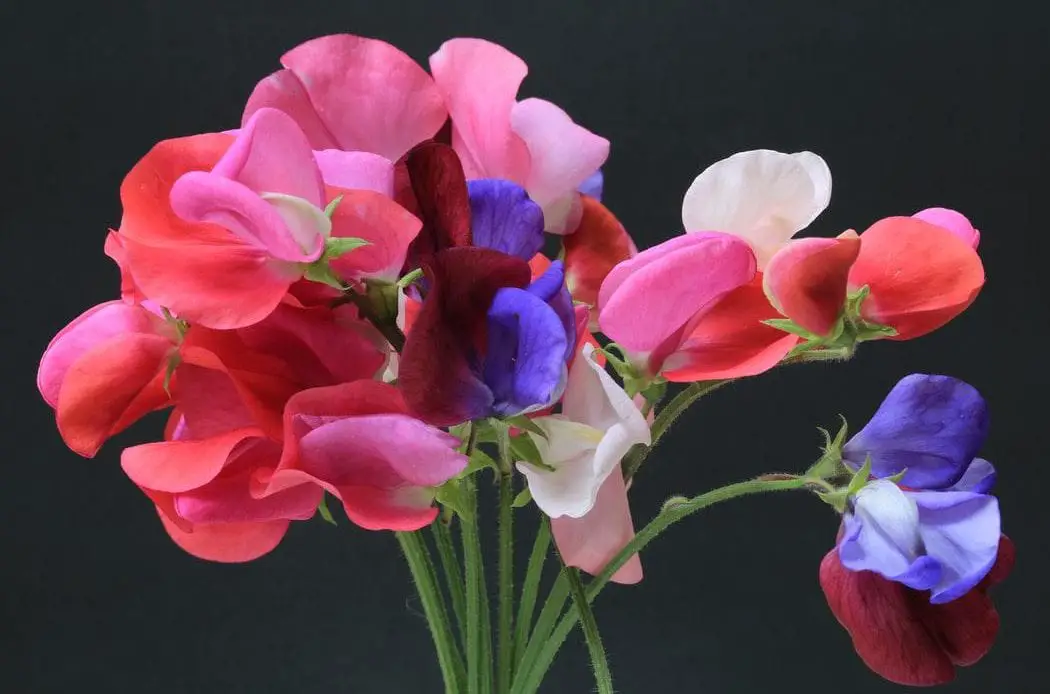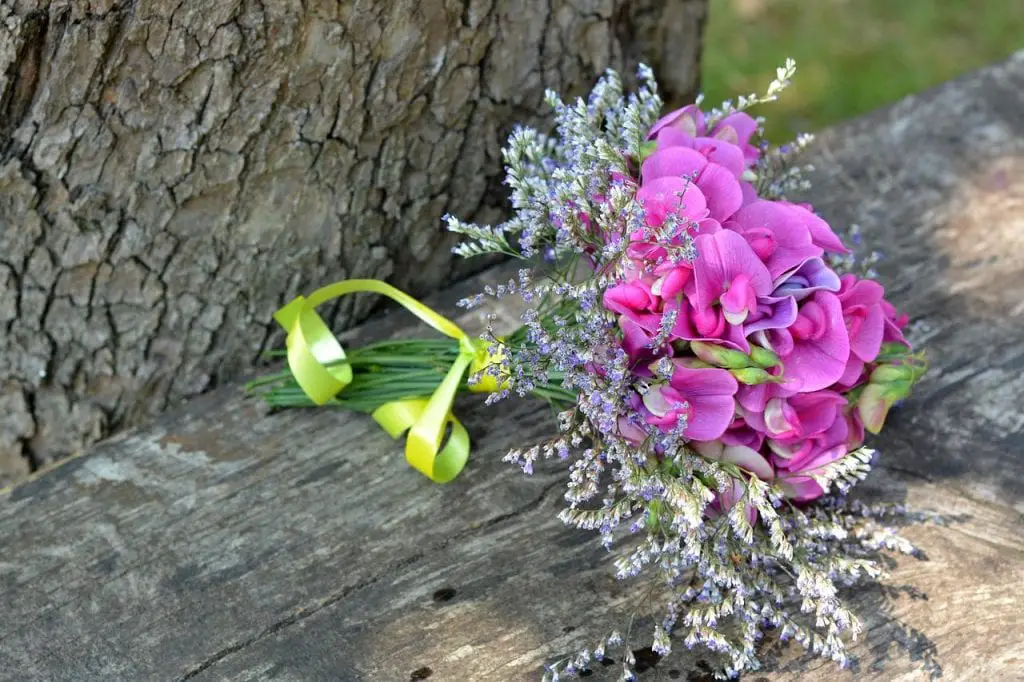
Colorful, frilly, and charming, sweet peas are among the most romantic and adored flowers in the garden. The easy to grow, butterfly-like blooms are eye candy and everybody loves having them around all through the year. A frequently asked question by gardening enthusiasts is – Are sweet peas perennial or do they last only for one season?
This question does not have a straightforward answer and needs some explanation. Most varieties of sweet peas are annual but there are perennial varieties that grow for many years. The everlasting sweet peas produce gaudy blooms in hues of red, white, pink, and pink-purple. When winter arrives the perennial sweet pea vines turn yellow and wither away. Come spring and they are back! The everlasting sweet pea vine keeps flowering in abundance starting from early summer and well into the fall.
It is not always easy to tell from the plants that are sweet peas perennial or belong to the annual variety.
The story of Sweet Peas
Sweet peas are versatile. They come in 110 or more species, most of which are annual. Lathyrus Latifolius is the most popularly grown perennial sweet peas. Another variety of the perennial sweet peas is Lathyrus Grandiflorus. It is a large, two flowers sweet pea usually blooming in shades of pink-purple. It’s considered to be more invasive and difficult to train when compared to the more popular choice Lathyrus Latifolius.
Sweet peas are native to Mediterranean countries like Italy, Sicily, and Cyprus and were later brought to England in the 17th century. From there they found their way into America and other countries around the world. These pretty, butterfly-like flowers gained popularity in the Victorian period. They found their place in potpourris, vases, bouquets, and table flower arrangements. Originally, perennial sweet peas were brought into England and America as wildflowers. Over the centuries they have naturalized to the soil and weather.
Annual sweet peas or Lathyrus Odoratus are popular cottage garden flowers that make great cut flowers. Both annual and perennial sweet peas are grown widely by gardening enthusiasts.
Answering to, are sweet peas perennial is rather tricky. Unlike other garden flower species, sweet peas are annual as well as perennial. Depending on which seeds you sow, your sweet peas will cheer you up with bright flowers for many years or will wither away after its blooming season is gone.
How can you tell if your sweet peas are annual or perennial?
The most noticeable difference between annual and perennial sweet peas is their flowers and how they smell. The annual sweet peas are gifted with a wonderful scent. Sadly, they survive only for a single season. The perennial sweet pea lacks the sweet aroma, but they are there year after year to adorn the garden with a burst of colors. Both attract bees, butterflies, and birds equally well to keep your garden full of fluttering visitors.
The herbaceous everlasting sweet pea grows up to 6 to 8ft (2.44 m). They are tough enough to even tolerate frost. These long-living vines sprawl in open areas and climb on any, supporting structure they find with their twining tendrils. They continue to grow throughout the year. When the summer nears its end, the sweet pea foliage turns yellowish and becomes rather dry and ragged. There is nothing to worry about – you need not even cut them back to get the foliage back in spring. It grows back naturally when the weather is congenial and keeps giving bright flowers for a long time.
The oval compound leaves of perennial sweet peas are broader and have a bluish or grayish-green shade compared to the brighter green of the annual varieties. The leaves are approximately 3inches (7.62 cm) long.
Reasons to choose perennial sweet peas over annuals
Perennial sweet peas are an excellent choice for screening and hedging. These vines can be trained to adapt to the landscape structure like fences and grow upwards or to trail off from a sloping structure like a terrace. The long-lasting variety is fast growing and can live up to ten under ideal conditions.
The annual sweet pea variety can mean a little more work compared to growing perennial sweet peas. The vines of the annual varieties dry off at the end of the season. If you are a stickler for a neat garden, you may have to uproot the vines when they are dead. An easier way to remove them is to allow the vines to dry at the end of the year. When the stems dry and turn brittle it is easy to pull them away from the fence, shrub, or the support which they have grown on. Trying to uproot them when they are still green may be a tougher job. With the long-lived sweet peas, it’s a natural course of their life-cycle to dry up and wake up again when spring returns.
While annual sweet peas are admired for their sweet scent and wide range of colors, they can be a bit difficult to grow and nurture. Perennial sweet peas are hardy, can tolerate great weather fluctuations, and don’t need much attention. Ensuring your perennial sweet peas don’t dry and wither off during summers is good enough to keep them blooming.

Annual or perennial, sweet peas are exquisite garden blooms
Whether annual or perennial, sweet peas are the most exquisite, old-fashioned garden flowers that demand every gardener’s attention. The gorgeous blooms appear for around one month in spring. The flowers appear in a wonderful medley of colors in long-stemmed sprays. Their fluted shapes and ruffled petals are fascinating.
Some things are common to both the varieties of sweet peas. The peas and flowers of both everlasting or annual sweet peas are not edible. They are poisonous for humans and animals like horses, sheep, cattle, and others due to the presence of an amino acid called oxalyldiaminopropionic acid.
The best part about perennial sweet peas is they can adapt to just about any indoor or outdoor garden style. Their adaptability allows them to grow extremely well on fences, trellis, chain links, and posts. The flowering vines have an informal flamboyance about them that’s impossible to ignore! They keep returning season after season, making your task easier.
Ideal growing conditions for everlasting pea vines
Although growing perennial sweet peas is easy, some conditions are quintessential to optimize flowering.
Perennial sweet pea vines need a partially shady or a sunny spot to grow well. They cannot tolerate standing water, so ensure you plant them in a well-drained spot that mostly remains moist and aerated. Sweet peas are very hardy, they can tolerate cold and frost and to a certain extent can also handle drought. But too much heat will reduce the production of flowers.
This vine can be grown in urban gardens also as it is not particularly fussy about soil types or the pollution level. Mostly, it can survive on all types of soil that are not too acidic or alkaline. These flowering vines grow with very little care. You can grow them in the flowerbeds in the garden or keep them indoors in a sunny spot in containers.
Gardeners often show concern over perennial sweet pea seeds becoming weedy and invasive. To keep avoid that from happening- trim off dry flowers as much as you can. This is also known as deadheading. That will encourage more flowers to grow in your vine and control pod and seed production. If you plan to keep some seeds for planting in other locations let the best flowers remain and dry out naturally to finally turn into seeds.
You may need to protect the seedlings from predators like snails and birds, but once well established, perennial sweet peas are reliable, hassle-free quick-growing plants.
Growing conditions for all sweet pea varieties are the same. The only difference when growing annual and perennial sweet peas are cutting back the perennials in autumn.
Some sweet facts about sweet peas
· Sweet peas are a popular gifting option. They are summer favorites and a real treat to receive. Owing to their colorful and intoxicatingly beautiful look, sweet peas can be styled into wonderful flower arrangements.
· These blooms make incredible cut flowers and last longer than you expect
· Sweet peas make excellent garden backdrops. They are great for fences and trellis.
· Sweet peas of any variety attract bees and butterflies who pollinate the fruit and vegetable plants in the garden.
· Sweet peas contribute to nitrogen fixation in the soil. Belonging to the legume family, sweet peas like clover and beans fixates inert nitrogen from the air to the ground. The process helps other plants to grow better.
If you wish for an armful of colorful flowers from your garden, sweet peas are good choices. The lovely cluster of colorful flowers is not worth missing. There are sweet peas perennial and annual, what suits you best is your choice. The long-living perennial sweet peas will keep your garden vibrant and attractive for years to come, drying up in winter and re-spouting every spring. In flower language, sweet peas symbolize goodbye and heavenly pleasure. The attractive flowers stand for fond memories.
